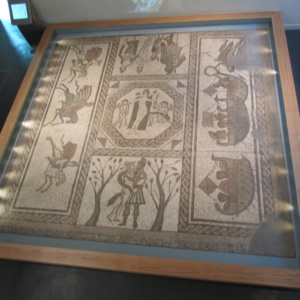A Visit to the Museum of Somerset
Thursday, May 16, 2013
Today, my Uncle Charlie’s friend, Mike, arranged for us to have a tour of the Museum of Somerset in Taunton. The museum building was originally constructed as a Norman castle, and was used in the twelfth-century civil war (between Stephen and Matilda). It was then used by the local bishops, and later by the courts of assize (travelling courts). It’s been a museum since 1870, and recently underwent three years of restoration. If you’re ever in Taunton, I would highly recommend a visit. It has a lot of hands-on exhibits, a number of audio stations, and some tactile games for the kids. Best of all, it’s completely free.
In the Great Hall
We met up with Mary, who works at the museum, and were led into what was originally the great hall of the castle. This space was full of early artefacts, ranging from ammonites the size of platters, to the only complete skeleton of a Plesiosaur, an early deep-sea predator that Mary described as looking like the Loch Ness monster. There were also a handful of large bones from a dinosaur that seems to be unique to Somerset; it’s called Camelotia because it was found near the presumed location of Avalon—I’m serious!
At the far end of the hall, just below the balcony so you could look down on it from upstairs, was a Roman mosaic, depicting the story of Dido and Aeneas. What makes this mosaic so special is the fact that it is almost completely intact. Mary explained that one of Rome’s finest artists would likely have been brought to Somerset to make this for a wealthy Roman landowner.
Settlement in Somerset
Next, we made our way upstairs, passing an earn that was found under the museum during restorations (it contained 52,503 Roman coins!), and made our way along the gallery, looking at the things early man had left behind: flint arrowheads; axes; ceramic bowls and beads; a piece of jade, which suggests there was trade between Somerset and Europe; and, perhaps most impressively, a wooden axe. This last was likely made for a child—as a toy so the boy could copy his father—and was preserved only because of the amount of peat in Somerset, which prevents wooden objects from rotting away.
In the Roman gallery, Mary showed us the museum’s collection of Roman broaches. These were made of everything from bronze to Welsh gold, which was a lovely dark gold colour. Then she brought us to a case that contained the bodies of a woman and her dog. The woman was about five foot four, and the dog she was buried with was about the size of a golden retriever. Mary said she felt very close to this woman, because she spent two days with one of the curators helping to lay her out properly in the case (originally, the woman’s torso and legs were laid out facing in different directions). Apparently, it wasn’t common for people to be buried with their pets, so this grave was a curiosity, besides being touching.
The English Civil War and Monmouth’s Rebellion
Next, we moved on to my favourite part of the tour: The English Civil War gallery and the Rebellion Room. Taunton changed hands a number of times during the English Civil War, moving from Royalist hands to parliamentarian control and back again. Lord Edward Wyndham, a local land owner, was involved in a number of negotiations between the Royalists and Parliamentarians, and even managed to negotiate the surrender after the Siege of Dunster Castle, which was concluded without bloodshed. Later in the day, I was able to handle a number of his letters at the Somerset Heritage Centre and Archives (again, thanks to Mike). The most interesting artefact in this room was—believe it or not—a skillet. I’m not big on historic cookware, but what made this interesting was the inscription on the handle: “C U B true to the King.” Seventeenth-century text-speak. 😉
The Rebellion Room is dedicated to artifacts from the Monmouth Rebellion of 1685 (also called the Pitchfork Rebellion, since most of the rebels were farmers). The supporters of James Scott, Duke of Monmouth, the illegitimate son of Charles II, were tried and executed by Judge Jefferies in the Bloody Assizes of 1685. The Rebellion Room is the cell in which they were held while awaiting their sentences. Written on the walls are some of their stories—one man, who was accused of firing the shot that warned the king’s men, was blamed by the women who came to visit other prisoners, though he protested until the day he was hanged that he had not fired the shot; a surgeon who was visiting Taunton when James Scott was declared king joined the pretender and was later transported; and a man who did not fight but who had been seen shaking the hand of the Duke of Monmouth was tried for treason and executed. “Sedgemoor,” one of my seventeenth-century short stories, is an account of the final battle of the Monmouth Rebellion from a Royalist perspective.
My favourite artefact in the Rebellion Room was a Royalist sword. It was the story behind the sword that made it interesting: a royalist soldier had made “unwanted advances” to a young girl’s mother, so the girl took the soldier’s sword and killed him. The royalists deemed the man’s behaviour dishonourable, and let the girl keep the sword as a souvenir, despite the fact that her family supported Monmouth.
Thanks to Mike and Mary for arranging today, and to Dad and Uncle Charlie for struggling through seventeenth-century manuscripts at the heritage centre—messy handwriting and pre-standardized spelling makes for awkward reading! Dad and I head to South Wales tomorrow where we’ll be staying with more of his family.

